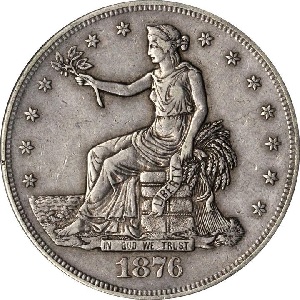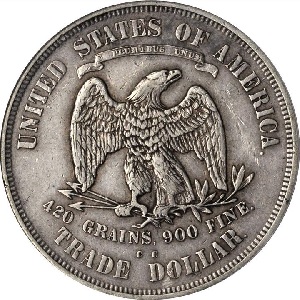1876-CC Trade Dollar
Throughout the late 1860’s and early 1870’s, American trade with countries in the Far East, particularly China, was moving along at a steady clip, but things could have been better.
To the dismay of American businessmen, Chinese merchants favored the Mexican peso as their medium of exchange, for it contained slightly more silver than a standard U.S. silver dollar. In order to compete in the region, the Yanks were forced to swap dollars for pesos, usually paying currency broker fees.(1)
In 1873, Congress sought to negate the peso's advantage and promote American commerce overseas at the same time by authorizing a new coin called the U.S. Trade Dollar. The Trade Dollar contained 1.8% more silver than the standard dollar.(2)
In 1876, trade dollar production at Carson City got off to a great start. By the end of April, 509,000 of them had been struck. At that point, manufacturing resources were redirected to the production of dimes, quarters, and half dollars. There were to be no more 1876-CC Trade dollars.(3)
There are multiple varieties of the 1876-CC involving two distinct reverse dies. Examples with Type 2 reverses are believed to be more common.(4)
As the 1876-CC Trade dollar value trends indicate, prices for grades EF-40 and lower have ascended steadily since 1990. However, in higher grades, we’ve seen mild setbacks since then, so bargain hunters may have an opportunity here (and then hope for a repeat performance of what occurred in higher grades prior to 1990).
| Estimated survivors in all grades: 300 ?
The survivor estimate from PCGS represents an average of one or more experts' opinions as to how many examples survive of a particular coin in all grades. Survival estimates include coins that are raw, certified by PCGS, and certified by other grading services. Learn more at PCGS. |
| PCGS Rarity Scale: 6.4 ?
The 'PCGS CoinFacts Rarity Scale' assesses the relative rarity of all U.S. coins, based on estimated surviving examples. The scale runs from 1.0 to 10.0. The higher the number, the rarer the coin.
Learn more at PCGS. |
| Click HERE to check for availability on eBay** |
Preview of eBay selection:
 |
 |
| Trendline Avg = 14.43 | GOOD |
Historic Value Trend Charts:
| Last updated 6-9-24 | Return to Key Date Coin List | |
| Compare to Common Date Coin of Same Type | ||
|
|
||
| Download Charts to Your Computer | ||
Sources
1. Taxay, Don. The U.S. Mint and Coinage. New York, NY: Sanford J. Durst Numismatic Publications, 1966.
2. Bowers, Q. David. The History of United States Coinage. Los Angeles, CA: Bowers and Ruddy Galleries, Inc., 1979.
3. Stack's Bowers Galleries. 1876-CC Trade Dollar. Type I/II. Tall CC. Aug 2012 Auction.
4. PCGS. 1876-CC T$1 (Regular Strike).
**Many very fine coin dealers sell on eBay. At any point in time, there may be over one million search results for United States coins. This includes quite a few of the recommendations on our Key Date Coin List.
If you’re thinking about purchasing a rare coin, eBay is certainly worth a look. For your convenience, the links from this site to eBay are coded to bring up only coins certified by PCGS and NGC.
As is always, always the case, never buy a valuable coin from a seller whose trustworthiness cannot be verified. Learn more about this at our chapter Best Places to Buy Coins, which also has a section on doing business on eBay.
In the interest of full disclosure, Rare Coins 101 receives a small commission anytime someone connects to eBay from this site and purchases something.
Coin images by Stack's Bowers Galleries.


